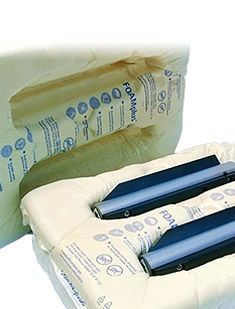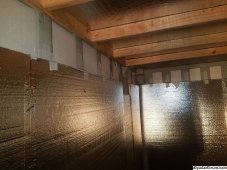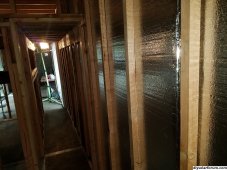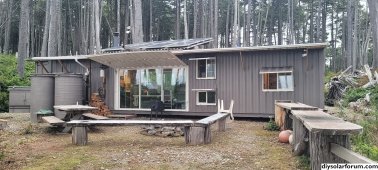I looked at the dominoe clamps. Very nice but to expensive for what they are. I bought 1/4” thick 4x4” metal plates, drilled a 3/4” hole in the middle and put them inside the corner castings of the container. I then laid the 8ft long 4x4 post on top of the corner casting. I then drilled a hole in the 4x4 post to line up with the metal plates inside the corner castings. Stuck a large bolt with washers through and tightened it down real tight to cinch the 4x4 post to the container. It worked extremely well and is very secure. My solar array is attached to it and has survived 60mph wind storms so far!@SoakedUp , you said “ I used 4x4s on the ends of the container bolted down at the corner iso attachment points. ”
Were those commercial ISO connectors like Domino Clamps or did you DIY something to attach the 4x4’s ?
Here is the Domino stuff for example :

Attach almost anything to shipping containers.
Domino Clamps create versatile fixing points on the corners of shipping containers. You can use them to attach almost anything to a shipping container without the need for welding or drilling.dominoclamps.com
You are using an out of date browser. It may not display this or other websites correctly.
You should upgrade or use an alternative browser.
You should upgrade or use an alternative browser.
Shipping Container solar AC
- Thread starter SoakedUp
- Start date
I was actually thinking of doing the exact same. Just needs a little air gap between the sun exposed material and the actual container wall to break the thermal conductivityThat looks great. Nice workmanship. Those new conex floors are pristine.
Strangely, my conex is already full of carp. And the floors are muddy. Weird. ?
On shading the outside, any barrier with an air gap will make a big difference for direct sun. Like the old safari land rovers. I was thinking of metal roofing attached with magnets on the sunny side. Should stick and it would take a heck of a wind to get underneath. Or a mixture of magnets and adhesive so you could mount and let it cure.
Also, if I didn’t mention earlier, Henry’s elastomeric cool roof paint is great on areas exposed to sun. The metal goes from too hot to touch to cool enough to lay on.
Anyway, well done.
Bluedog225
Texas
- Joined
- Nov 18, 2019
- Messages
- 2,921
What did you use for that vent hole cover? Looks good.
And I gotta ask, where is your big pile of junk? I’ve never seen a conex so tidy. ?
And I gotta ask, where is your big pile of junk? I’ve never seen a conex so tidy. ?
KITROBASKIN
Solar Enthusiast
I used insofast shipping container insulation; did not do cost analysis but works well. We put additional insulation over the insofast.
I had some left over metal wire screen from another project. I cut it to shape then found a 6” plastic hvac duct connector on Amazon. It fit the AC exhaust perfectly and keeps any larger insects like scorpions, tarantulas, and mice from going up the hole.What did you use for that vent hole cover? Looks good.
And I gotta ask, where is your big pile of junk? I’ve never seen a conex so tidy. ?
My OCD gets the best of me when it comes to junk and clutter. I’m a bit of a minimalist
FilterGuy
Solar Engineering Consultant - EG4 and Consumers
Shading the outside is smart!! Other folks have reported that insulating the *outside* of a container is more effective than the inside.I’m also in the process of some kind of awning or shading for the sides of the container.
Yeah, putting the thermal mass of the container inside your insulation envelope with an external radiant barrier means the internal loads are lower peak and less total energy.Shading the outside is smart!! Other folks have reported that insulating the *outside* of a container is more effective than the inside.
SilverbackMP
Solar Addict
- Joined
- Apr 4, 2022
- Messages
- 928
I’ve been looking at that stuff. I just hate paying near spray foam prices for what amounts to the same stuff they make disposable bait coolers and foam padding for boxes out of. I get that it also provides sheathing attachment, but I wouldn’t try hanging inverters from it.I used insofast shipping container insulation; did not do cost analysis but works well. We put additional insulation over the insofast.
Thus my idea of cutting my own XPS panels to fit…either with a table saw or track saw. And then framing out with 2x3s, 2x4s, or heavier gauge metal studs, possibly adding some rock wool in the cavities. Then 3/4 ply (attachment points anywhere) followed by 5/8 Sheetrock (fire barrier).
I wouldn’t do the Sheetrock a space without all of the electronics. Probably go down to 1/4 ply in containers that were going to be conditioned space only and shelving units used.
Last edited:
Hedges
I See Electromagnetic Fields!
- Joined
- Mar 28, 2020
- Messages
- 20,699
Is foam in place insulation Urethane, vs. foam in place packing material is Styrofoam?

 www.unipaq.com
www.unipaq.com
Maybe that could be done, with plywood form and plastic sheet for mold release?
Or if you could roll container so insulating a horizontal surface, dispense and level with a screed.
Would want covered with fire retardant material, however. Maybe glue on sheetrock.

Expanding Foam Packaging - Unipaq, Inc.
Protect your fragile items with Foam-in-Place or Expanding Foam Packaging that easily fills the space around your product.
 www.unipaq.com
www.unipaq.com
Maybe that could be done, with plywood form and plastic sheet for mold release?
Or if you could roll container so insulating a horizontal surface, dispense and level with a screed.
Would want covered with fire retardant material, however. Maybe glue on sheetrock.
It’s those damn metal walls. When the sun hits them they get really hot. On the plus side, if any mold does grow on the inside the direct sun on the container will heat the walls up to a temperature that will most likely kill any mold growth. Mold is pretty rare in my area though with only 5” of annual rain, high winds, hot temps, and very dry weather. Most of winter, like right now, humidity is only 10-20%Shading the outside is smart!! Other folks have reported that insulating the *outside* of a container is more effective than the inside.
Checkthisout
Solar Wizard
- Joined
- Nov 14, 2021
- Messages
- 4,819
Insofast makes corrugation fillers. This makes it easy if you want to then source local foam sheets and do your own framing.
I used their corrugation fillers, then put 1" foam over that, foil-taped the seams, then put the framing over that, then put 1-1/2" foam in framing cavity.
Foe the ceiling same thing but framing was thicker and then filled cavity with fiberglass.
It's a high-cube so there was a seam at the top so you can kind of get an idea of what it looked like here before I cut, fit, and taped the top piece of wall foam.



I used their corrugation fillers, then put 1" foam over that, foil-taped the seams, then put the framing over that, then put 1-1/2" foam in framing cavity.
Foe the ceiling same thing but framing was thicker and then filled cavity with fiberglass.
It's a high-cube so there was a seam at the top so you can kind of get an idea of what it looked like here before I cut, fit, and taped the top piece of wall foam.



Checkthisout
Solar Wizard
- Joined
- Nov 14, 2021
- Messages
- 4,819
That looks great. Nice workmanship. Those new conex floors are pristine.
Strangely, my conex is already full of carp. And the floors are muddy. Weird. ?
On shading the outside, any barrier with an air gap will make a big difference for direct sun. Like the old safari land rovers. I was thinking of metal roofing attached with magnets on the sunny side. Should stick and it would take a heck of a wind to get underneath. Or a mixture of magnets and adhesive so you could mount and let it cure.
Also, if I didn’t mention earlier, Henry’s elastomeric cool roof paint is great on areas exposed to sun. The metal goes from too hot to touch to cool enough to lay on.
Anyway, well done.
I would never build out a container without a secondary metal roof on top.
Framing and installing a metal roof on one barely takes a day but adds so much. You get a slope, eaves, sunblockage, solar panel mounting points all in one fell swoop.
SilverbackMP
Solar Addict
- Joined
- Apr 4, 2022
- Messages
- 928
I didn’t consider using only their inserts rather than their complete system. This might be the ticket.Insofast makes corrugation fillers. This makes it easy if you want to then source local foam sheets and do your own framing.
I used their corrugation fillers, then put 1" foam over that, foil-taped the seams, then put the framing over that, then put 1-1/2" foam in framing cavity.
Foe the ceiling same thing but framing was thicker and then filled cavity with fiberglass.
It's a high-cube so there was a seam at the top so you can kind of get an idea of what it looked like here before I cut, fit, and taped the top piece of wall foam.
View attachment 177869View attachment 177871View attachment 177870
sunshine_eggo
Happy Breffast!
I can't get over the cost of the insofast stuff... even just the inserts.
Checkthisout
Solar Wizard
- Joined
- Nov 14, 2021
- Messages
- 4,819
I can't get over the cost of the insofast stuff... even just the inserts.
Math-wise it works it also saves a lot of time. I didn't do it though because of all the weird stuff I did.
The corrugation fillers are worth it. I think it was $600.00 to do the walls and ceilings of my 45'.
The cheapest way is use the glue-on pegs and then use vinyl-backed stuff they use in metal buildings.
Checkthisout
Solar Wizard
- Joined
- Nov 14, 2021
- Messages
- 4,819
I didn’t consider using only their inserts rather than their complete system. This might be the ticket.
It helps. So, the key with any insulation on these things is make sure no air can touch the wall. Any insulation system you use is fine so long as there is an impermeable barrier with no air leaks.
For this reason, I would not leave the air gap like the OP did. Probably doesn't matter in that dry climate but if you're heating the thing in the cold, any little air leak that allowed air to get in and circulate into that cavity is going to condense.
Bluedog225
Texas
- Joined
- Nov 18, 2019
- Messages
- 2,921
Yeah, but a gap and Mylar does a fair bit to address the sun on hot metal issue.
I agree. Very easy to add a second roof. It was the first thing I did when I got my container. It’s my west wall that is getting tortured by the evening sun. But I think I have a good solution to get it shaded.I would never build out a container without a secondary metal roof on top.
Framing and installing a metal roof on one barely takes a day but adds so much. You get a slope, eaves, sunblockage, solar panel mounting points all in one fell swoop.
Your container looks great. I looked at the insofast stuff but it was just so expensive for what it is. I left enough room in my plans to add either more framing or another layer of 2” foam panels. I like doing things in stages to see how they work then add more if needed.
Honestly the only real solution to no air is spray foam. Anything else it doesn’t matter if it’s a 1/16”or 2” gap. Also, air is a fairly good insulator and insulation material typically works better if it’s not packed in super tight.It helps. So, the key with any insulation on these things is make sure no air can touch the wall. Any insulation system you use is fine so long as there is an impermeable barrier with no air leaks.
For this reason, I would not leave the air gap like the OP did. Probably doesn't matter in that dry climate but if you're heating the thing in the cold, any little air leak that allowed air to get in and circulate into that cavity is going to condense.
Checkthisout
Solar Wizard
- Joined
- Nov 14, 2021
- Messages
- 4,819
Yeah, but a gap and Mylar does a fair bit to address the sun on hot metal issue.
Again, if it works it works but I would opt to roof the outside and get some eaves and shade the container that way.
I was only going to put the roof that the panels are mounted on but then opted to do the whole container.
12' x 3' metal sheets are currently $50.00 at homes depot so 15 sheets, $750.00 plus framing. Maybe $1600.00 all done. Half that for a 20 foot container. ?

Similar threads
- Replies
- 39
- Views
- 2K
- Replies
- 7
- Views
- 257
- Replies
- 60
- Views
- 4K


